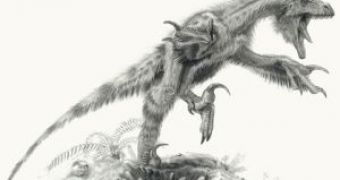Scientists have found the first dinosaur fossils ever in Nevada, a finding that expands the known range of the dinosaurs 400 km further west in North America and offers a new understanding of life in the state some 100 million years ago.
The fossils included a dromaeosaurus (a small feathered carnivorous dinosaur) (image) femur, the teeth of a sauropod (giant long necked herbivorous), a tyrannosauroid (giant carnivorous related to Tyrannosaurus) and an iguanodont (bipedal herbivorous dinosaur) and unidentified dinosaur eggshell fragments. "The remnants, found at secret excavation sites in southern Nevada, pushed the known range of the ancient reptiles about 250 miles farther west," said Joshua Bonde, a graduate earth science student at Montana State University. "Most of these groups of dinosaurs are known from other places in the United States," he said. And Canada, we may add. "What we're able to do is push the ranges of these animals all the way up to Nevada now, where previously the farthest west they've been is east-central Utah."
On the site, there will be built a future state museum, housing Nevada's dinosaur fossils. The beneficiary of some of the artifacts will be the new Nevada State Museum, expected to open in July 2008 at the Springs Preserve site in Las Vegas. "We didn't even think we had dinosaurs here," museum director Greta Brunschwyler said. "It marked a breakthrough in a state that had only turned up marine fossils until now," said Eugene Hattori, the state's curator of anthropology.
The state's territory was mostly underwater more than 200 million years ago, but the seas receded about 145 million years ago. Even so, insofar ancient terrestrial animals have never been found before in Nevada. "We were getting seashells, ammonites (ancient shelled squids) and crinoids (a type of starfish) and that sort of thing, and ichthyosaurs, the big marine reptile, but we have not had the terrestrial fossils until Josh did his work," Hattori said.
"Now we can put animals on the land. It helps us understand the whole landscape much more clearly," said geology professor Stephen Rowland of the University of Nevada, Las Vegas.
Bonde and his supervisor, Montana State paleontologist Dave Varricchio, discovered fossils of turtle shells and dinosaur teeth on what later became an excavation site in March 2005. "If you find fossils on the surface, it's kind of like smoke, like there's something else," Bonde said. "The area is believed to have once been a flood plain where the creatures lived and died for many generations from 112 million to 99 million years ago", Bonde said. "When it floods you get all this mud on the surface outside the river channel. Those muds are what we find most of these fossils in," he said.

 14 DAY TRIAL //
14 DAY TRIAL //